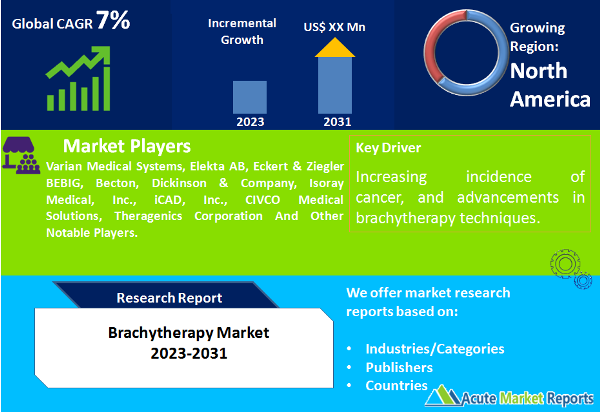
Brachytherapy, a vital component of modern cancer treatment, offers a targeted approach to delivering radiation therapy, which is crucial in managing various types of cancer. The brachytherapy market is expected to grow at a CAGR of 7% during the forecast period of 2025 to 2033, driven by the demand for precise and targeted cancer treatment, the increasing incidence of cancer, and advancements in brachytherapy techniques. While the shortage of skilled professionals and infrastructure presents a restraint, efforts are ongoing to address these challenges. Market segmentation by dosage and product provides insights into specific areas of growth, and geographic trends highlight the importance of regional variations in demand. Competitive players are expected to continue their emphasis on innovation, partnerships, and product diversification to meet the evolving needs of cancer patients and healthcare providers.

Precise and Targeted Cancer Treatment
One of the primary drivers of the Brachytherapy market is its ability to deliver precise and targeted cancer treatment. Brachytherapy involves the placement of radioactive sources directly into or adjacent to the tumor site. This localized radiation therapy minimizes damage to healthy surrounding tissues while maximizing the radiation dose delivered to the tumor. The ability to spare healthy tissues and organs from radiation exposure significantly reduces the side effects of treatment and enhances patient outcomes.
Increasing Incidence of Cancer
The global increase in the incidence of cancer is a significant driver for the Brachytherapy market. Cancer is a leading cause of mortality worldwide, and the burden of cancer is expected to rise in the coming years. Brachytherapy plays a crucial role in the treatment of various cancers, including prostate cancer, cervical cancer, and breast cancer. The rising prevalence of cancer necessitates effective treatment modalities, making brachytherapy a key component in the fight against cancer.
Advancements in Brachytherapy Techniques
Advancements in brachytherapy techniques and technologies have driven the market's growth. Modern brachytherapy has evolved with innovations such as image-guided brachytherapy, 3D treatment planning, and adaptive radiation therapy. These technologies enable healthcare providers to plan and deliver brachytherapy with unprecedented precision and accuracy. Furthermore, the development of new brachytherapy products and treatment approaches has expanded the range of cancers that can be effectively treated with this modality.
Restraint in the Brachytherapy Market
A notable restraint in the Brachytherapy market is the limited availability of skilled professionals and infrastructure for brachytherapy. The successful implementation of brachytherapy requires a highly specialized team of radiation oncologists, medical physicists, and radiation therapists. Additionally, healthcare facilities need to invest in state-of-the-art equipment and infrastructure to perform brachytherapy procedures. The shortage of skilled professionals and the high upfront costs associated with establishing brachytherapy programs can limit its accessibility, particularly in resource-constrained regions.
Market Segmentation by Dosage (High-Dose Rate Brachytherapy, Low-Dose Rate Brachytherapy): High-Dose Rate (HDR) Brachytherapy Dominates the Market
The Brachytherapy market can be segmented by dosage into two categories: High-Dose Rate (HDR) Brachytherapy and Low-Dose Rate (LDR) Brachytherapy. In 2024, "High-Dose Rate (HDR) Brachytherapy" generated the highest revenue. The increased adoption of HDR brachytherapy is attributed to its shorter treatment duration and adaptability to various cancer types. For the period from 2025 to 2033, "Low-Dose Rate (LDR) Brachytherapy" is expected to exhibit the highest compound annual growth rate (CAGR). LDR brachytherapy is anticipated to find applications in prostate cancer and other tumor sites, making it a promising growth segment.
Market Segmentation by Product (Seeds, Applicators & Afterloaders, Electronic Brachytherapy): Seeds Dominate the Market
The Brachytherapy market can be segmented by product into three categories: seeds, applicators & afterloaders, and electronic brachytherapy. In 2024, "seeds" witnessed the highest revenue. Radioactive seeds are widely used in prostate cancer treatment and serve as an effective treatment modality. For the period from 2025 to 2033, "electronic brachytherapy" is expected to experience the highest CAGR. The demand for non-invasive and versatile electronic brachytherapy systems is projected to drive growth in this product segment.
North America Remains the Global Leader
The Brachytherapy market exhibits geographic variations in demand and growth. Geographic trends indicate that regions with a high burden of cancer, well-established healthcare infrastructure, and advancements in cancer care tend to lead in brachytherapy utilization. North America, with its advanced healthcare systems, has been a prominent market for brachytherapy. When considering the region with the highest CAGR during the forecast period from 2025 to 2033, Asia-Pacific is expected to exhibit substantial growth. The region's increasing cancer incidence, improving healthcare infrastructure, and efforts to enhance cancer care are driving the demand for brachytherapy. In terms of revenue percentage, North America is expected to maintain its position as the region with the highest revenue percentage throughout the forecast period. The region's investment in cancer research, access to advanced medical technologies, and increasing adoption of brachytherapy contribute to its prominence in the market.
Competitive Trends, Top Players, and Key Strategies
The Brachytherapy market features several key players, including Varian Medical Systems, Elekta AB, Eckert & Ziegler BEBIG, Becton, Dickinson & Company, Isoray Medical, Inc., iCAD, Inc., CIVCO Medical Solutions, Theragenics Corporation. These companies employ specific strategies to maintain and expand their market presence. In 2024, Varian Medical Systems held a significant market share, offering a comprehensive range of brachytherapy solutions and radiation therapy equipment. The company's strategy focused on product innovation and partnerships with healthcare institutions to expand their reach. Elekta AB, a global leader in radiotherapy solutions, excelled in providing advanced brachytherapy systems. Their strategy emphasized research and development, with a focus on introducing cutting-edge technologies and treatment planning software. Eckert & Ziegler BEBIG, a prominent player in brachytherapy products, positioned itself as a key player in the market. Their strategy centered on diversifying their product portfolio to cater to a broad range of brachytherapy applications. For the forecast period from 2025 to 2033, these companies are expected to continue their strategies, focusing on innovation, collaborations with healthcare providers, and expanding their product offerings to meet the evolving demands of the brachytherapy market.
Historical & Forecast Period
This study report represents analysis of each segment from 2023 to 2033 considering 2024 as the base year. Compounded Annual Growth Rate (CAGR) for each of the respective segments estimated for the forecast period of 2025 to 2033.
The current report comprises of quantitative market estimations for each micro market for every geographical region and qualitative market analysis such as micro and macro environment analysis, market trends, competitive intelligence, segment analysis, porters five force model, top winning strategies, top investment markets, emerging trends and technological analysis, case studies, strategic conclusions and recommendations and other key market insights.
Research Methodology
The complete research study was conducted in three phases, namely: secondary research, primary research, and expert panel review. key data point that enables the estimation of Brachytherapy market are as follows:
Market forecast was performed through proprietary software that analyzes various qualitative and quantitative factors. Growth rate and CAGR were estimated through intensive secondary and primary research. Data triangulation across various data points provides accuracy across various analyzed market segments in the report. Application of both top down and bottom-up approach for validation of market estimation assures logical, methodical and mathematical consistency of the quantitative data.
| ATTRIBUTE | DETAILS |
|---|---|
| Research Period | 2023-2033 |
| Base Year | 2024 |
| Forecast Period | 2025-2033 |
| Historical Year | 2023 |
| Unit | USD Million |
| Segmentation | |
Dosage Type
| |
Product
| |
Application
| |
|
Region Segment (2023-2033; US$ Million)
|
Key questions answered in this report